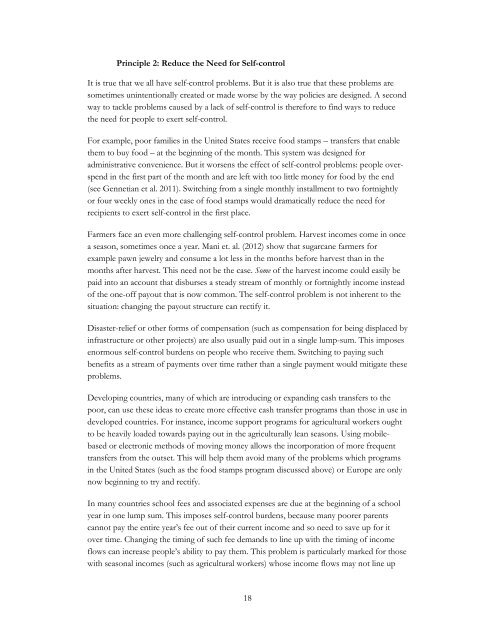1426679 file datta mullainathan behavioral design
1426679 file datta mullainathan behavioral design
1426679 file datta mullainathan behavioral design
Create successful ePaper yourself
Turn your PDF publications into a flip-book with our unique Google optimized e-Paper software.
Principle 2: Reduce the Need for Self-control<br />
It is true that we all have self-control problems. But it is also true that these problems are<br />
sometimes unintentionally created or made worse by the way policies are <strong>design</strong>ed. A second<br />
way to tackle problems caused by a lack of self-control is therefore to find ways to reduce<br />
the need for people to exert self-control.<br />
For example, poor families in the United States receive food stamps – transfers that enable<br />
them to buy food – at the beginning of the month. This system was <strong>design</strong>ed for<br />
administrative convenience. But it worsens the effect of self-control problems: people overspend<br />
in the first part of the month and are left with too little money for food by the end<br />
(see Gennetian et al. 2011). Switching from a single monthly installment to two fortnightly<br />
or four weekly ones in the case of food stamps would dramatically reduce the need for<br />
recipients to exert self-control in the first place.<br />
Farmers face an even more challenging self-control problem. Harvest incomes come in once<br />
a season, sometimes once a year. Mani et. al. (2012) show that sugarcane farmers for<br />
example pawn jewelry and consume a lot less in the months before harvest than in the<br />
months after harvest. This need not be the case. Some of the harvest income could easily be<br />
paid into an account that disburses a steady stream of monthly or fortnightly income instead<br />
of the one-off payout that is now common. The self-control problem is not inherent to the<br />
situation: changing the payout structure can rectify it.<br />
Disaster-relief or other forms of compensation (such as compensation for being displaced by<br />
infrastructure or other projects) are also usually paid out in a single lump-sum. This imposes<br />
enormous self-control burdens on people who receive them. Switching to paying such<br />
benefits as a stream of payments over time rather than a single payment would mitigate these<br />
problems.<br />
Developing countries, many of which are introducing or expanding cash transfers to the<br />
poor, can use these ideas to create more effective cash transfer programs than those in use in<br />
developed countries. For instance, income support programs for agricultural workers ought<br />
to be heavily loaded towards paying out in the agriculturally lean seasons. Using mobilebased<br />
or electronic methods of moving money allows the incorporation of more frequent<br />
transfers from the outset. This will help them avoid many of the problems which programs<br />
in the United States (such as the food stamps program discussed above) or Europe are only<br />
now beginning to try and rectify.<br />
In many countries school fees and associated expenses are due at the beginning of a school<br />
year in one lump sum. This imposes self-control burdens, because many poorer parents<br />
cannot pay the entire year’s fee out of their current income and so need to save up for it<br />
over time. Changing the timing of such fee demands to line up with the timing of income<br />
flows can increase people’s ability to pay them. This problem is particularly marked for those<br />
with seasonal incomes (such as agricultural workers) whose income flows may not line up<br />
18


